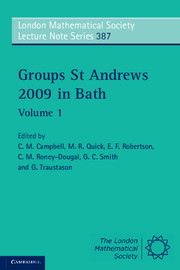Book contents
- Frontmatter
- Contents
- Introduction
- A speech in honour of John Cannon and Derek Holt
- Finite groups of Lie type and their representations
- Iterated monodromy groups
- Engel elements in groups
- Some classes of finite semigroups with kite-like egg-boxes of D-classes
- Structure of finite groups having few conjugacy class sizes
- Group theory in cryptography
- A survey of recent results in groups and orderings: word problems, embeddings and amalgamations
- A survey on the minimum genus and maximum order problems for bordered Klein surfaces
- On one-relator quotients of the modular group
- Miscellaneous results on supersolvable groups
- Automorphisms of products of finite groups
- A rational property of the irreducible characters of a finite group
- Automotives
- On n-abelian groups and their generalizations
- Computing with matrix groups over infinite fields
- Trends in infinite dimensional linear groups
- Engel conditions on orderable groups and in combinatorial problems (a survey)
- References
Iterated monodromy groups
Published online by Cambridge University Press: 05 July 2011
- Frontmatter
- Contents
- Introduction
- A speech in honour of John Cannon and Derek Holt
- Finite groups of Lie type and their representations
- Iterated monodromy groups
- Engel elements in groups
- Some classes of finite semigroups with kite-like egg-boxes of D-classes
- Structure of finite groups having few conjugacy class sizes
- Group theory in cryptography
- A survey of recent results in groups and orderings: word problems, embeddings and amalgamations
- A survey on the minimum genus and maximum order problems for bordered Klein surfaces
- On one-relator quotients of the modular group
- Miscellaneous results on supersolvable groups
- Automorphisms of products of finite groups
- A rational property of the irreducible characters of a finite group
- Automotives
- On n-abelian groups and their generalizations
- Computing with matrix groups over infinite fields
- Trends in infinite dimensional linear groups
- Engel conditions on orderable groups and in combinatorial problems (a survey)
- References
Summary
Abstract
The paper is a survey of topics related to the theory of iterated monodromy groups and its applications. We also present a collection of examples illustrating different aspects of the theory.
Introduction
Iterated monodromy groups are algebraic invariants of topological dynamical systems (e.g., rational functions acting on the Riemann sphere). They encode in a computationally efficient way combinatorial information about the dynamical systems. In hyperbolic (expanding) case the iterated monodromy group contains all essential information about the dynamical system. For instance, the Julia set of the system can be reconstructed from the iterated monodromy group).
Besides their applications to dynamical systems (see, for instance [BN06] and [Nek08b]) iterated monodromy groups are interesting from the point of view of group theory, as they often possess exotic properties. In some sense their complicated structure is parallel to the complicated structure of the associated fractal Julia sets. In some cases the relation with the dynamical systems can be used to understand algebraic properties of the iterated monodromy groups.
Even though the main application of the iterated monodromy groups is dynamics, their origins are in algebra (however, some previous works in holomorphic dynamics contained constructions directly related to the iterated monodromy groups, see [HOV95, LM97, Pil00]). They were defined in 2001 in connection with the following construction due to R. Pink. Let F(x) be a rational function over ℂ.
- Type
- Chapter
- Information
- Groups St Andrews 2009 in Bath , pp. 41 - 93Publisher: Cambridge University PressPrint publication year: 2011
References
- 6
- Cited by



